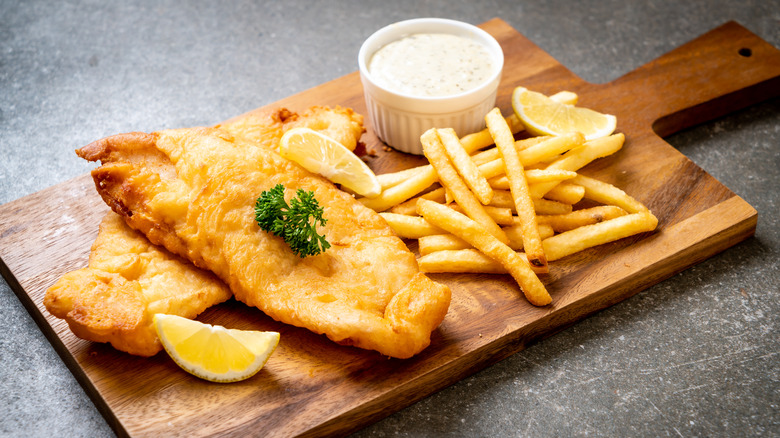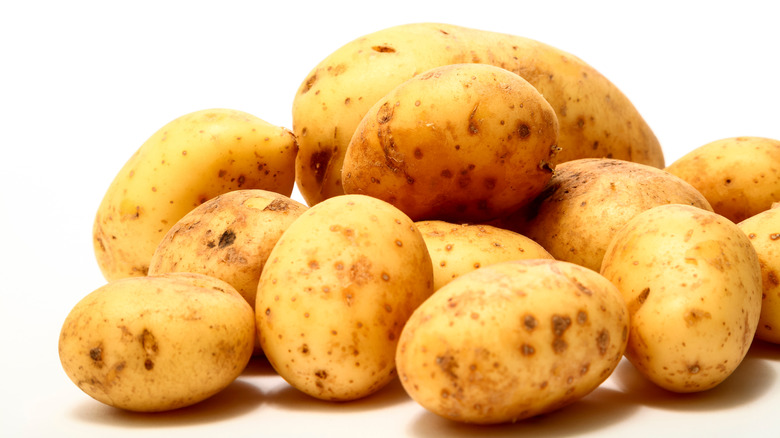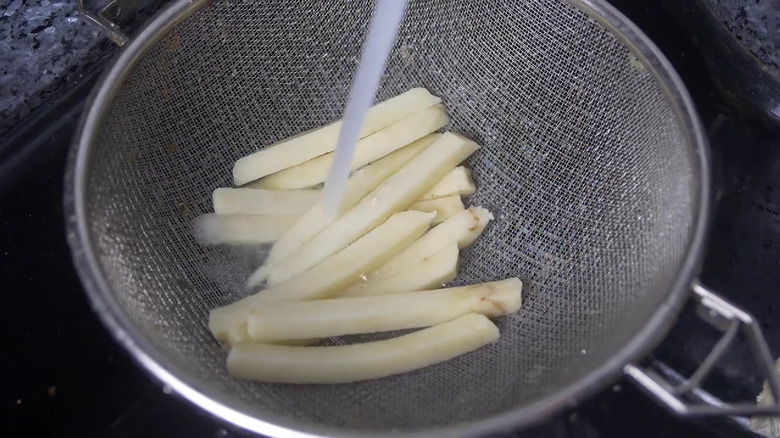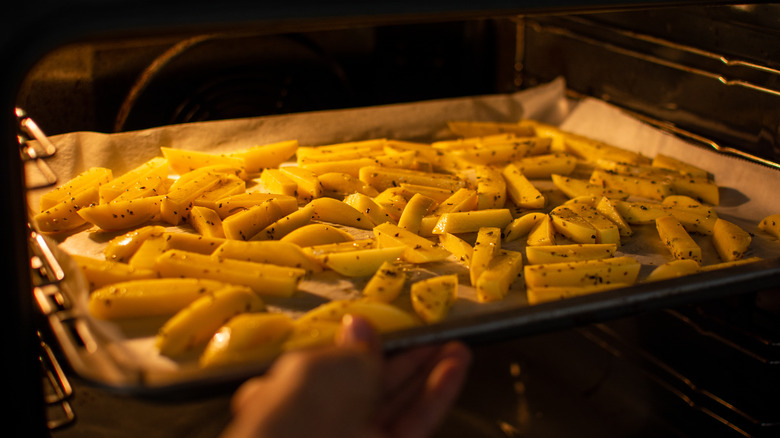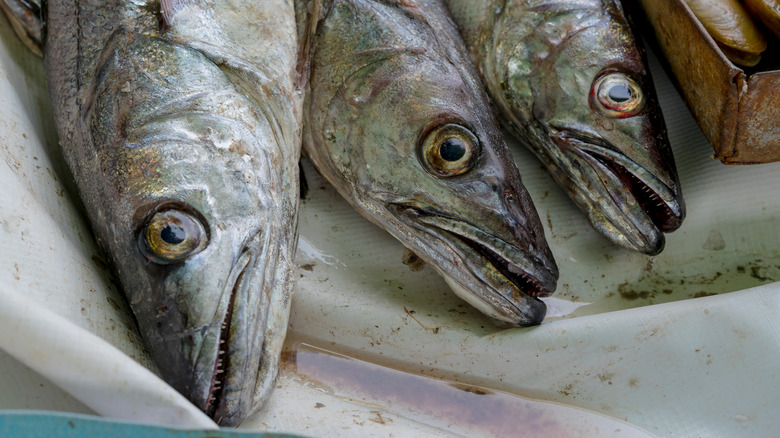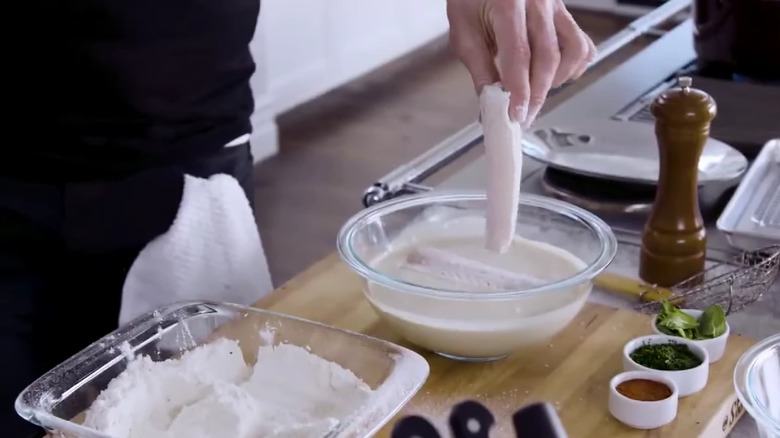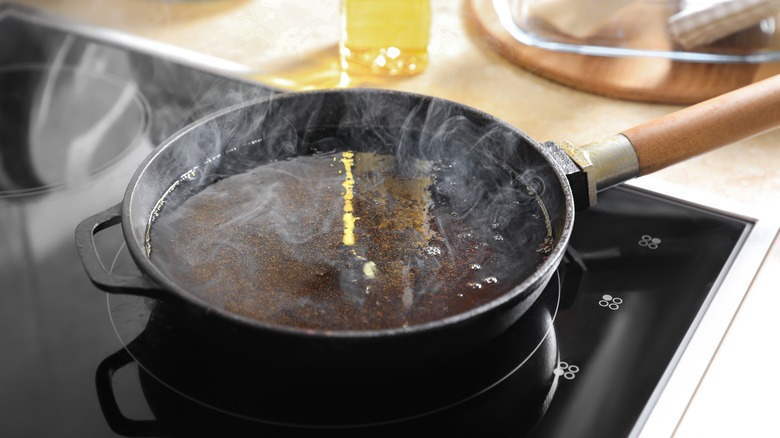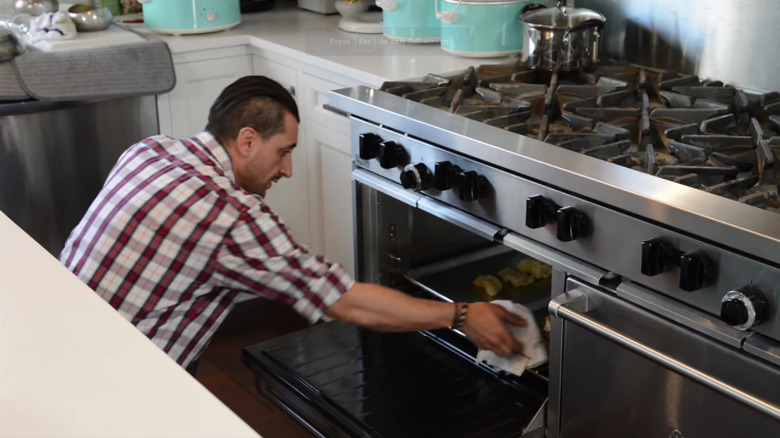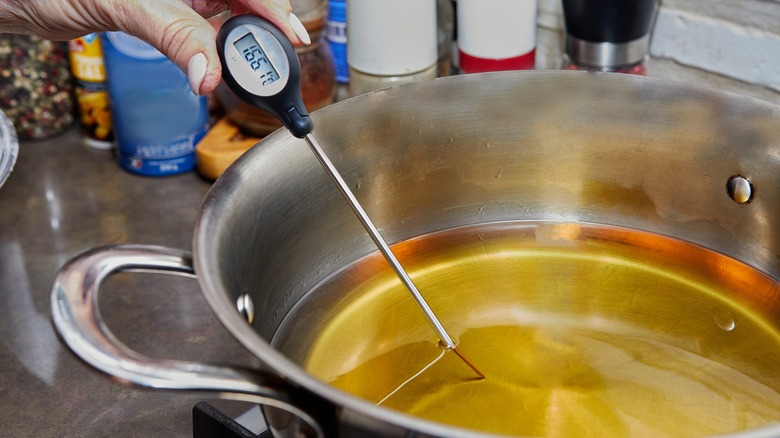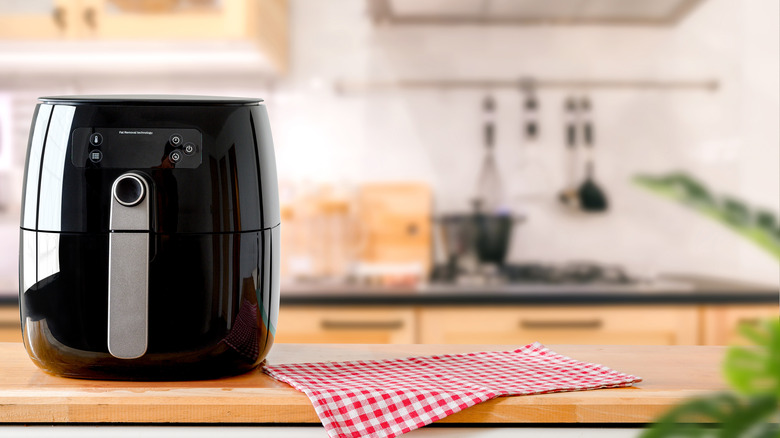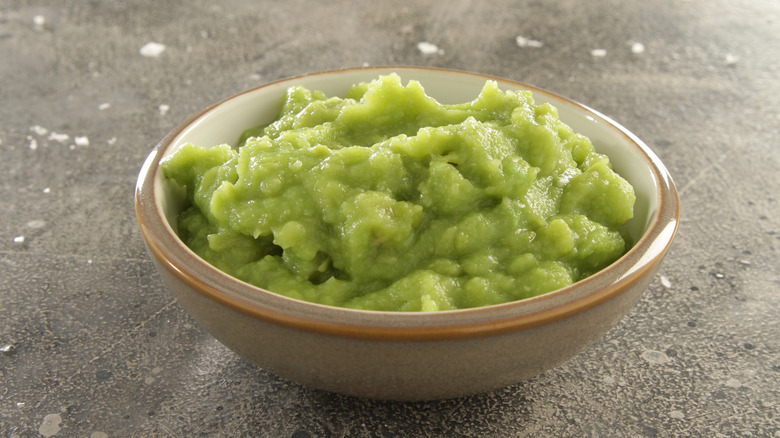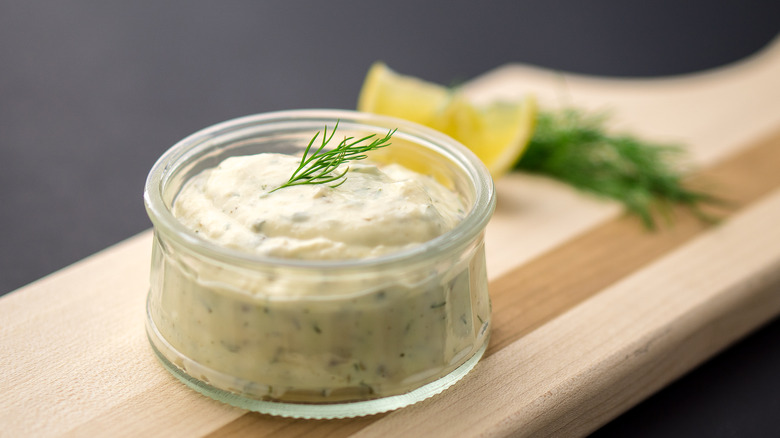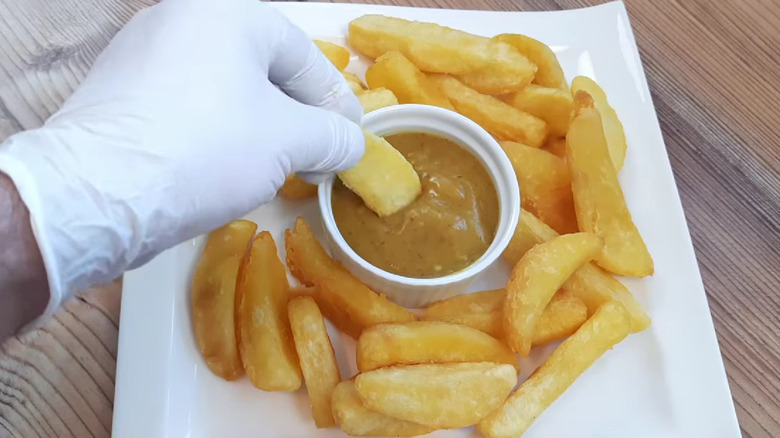12 Mistakes You're Making With Homemade Fish And Chips
According to the BBC, Britons alone consume some 229 million portions of fish and chips per year. The dish is embedded in British culture; it is often labeled as one of the United Kingdom's national dishes and has been popular for over a century. Most British people go to their local "chippie" when they fancy a paper-wrapped serving of vinegar soaked fish and chips, but it is a true testament to the popularity of the dish that it's also found in some of the country's swankiest establishments. These include Tom Kerridge's Bar & Grill in London where a serving of fish and chips costs approximately $40.
For those wishing to make fish and chips at home, several challenges present themselves. These include how to achieve perfectly crisp, golden chips and an evenly battered, moist piece of fish. Failure to meet these challenges may see your dish turn out a soggy, bland, and time consuming mess. Fortunately, we have identified the main mistakes people make when cooking homemade fish and chips. Avoiding these slip-ups will see your fish and chip game elevated to the level of the pros. Who knows, you might get away with charging your guests $40 for it, too.
1. Using the wrong kind of potatoes
The first and most important decision any chef will make when cooking fries — or, as we will refer to them in this article, chips — is what type of potatoes to use. All 500-plus varieties of potatoes fall roughly into two groups: waxy or floury. For chips, floury potatoes are better because of their high starch content and low moisture levels. This allows both a crisp exterior and light, fluffy interior to develop during the cooking process. Floury potato varieties that are great for chip making include Maris Piper, Russet, Idaho, and Yukon Gold.
In contrast, waxy potatoes have low starch contents and high levels of moisture. This allows them to keep their shape when cooked, making them suitable for dishes like potato salad. However, the interior of these potatoes does not develop the fluffy texture so many of us crave in chips. As such, waxy varieties like Jersey Royal, Charlotte, and baby potatoes should be avoided when making traditional fish and chips.
2. Forgetting to wash your uncooked chips
Once potatoes have been purchased and peeled you would be forgiven for thinking they are ready for cooking. However, this is not the case, as Chef Ligia Lugo — co-founder of The Daring Kitchen and Vie De La Vegan — explained during an interview with SL Man. "Soak the potatoes in cold water after cutting for at least half an hour. This will remove a lot of the starch and result in crispier potatoes. It also prevents the sugars from browning before the potatoes are cooked. Dry them thoroughly after soaking them so they don't steam and get soft in the oven." It is essential that washing is carried out as this removes excess surface starch. Failing to do so will limit the amount of moisture that escapes from the chips during cooking, resulting in chips that are soft instead of crisp and fluffy.
Also, washing the cut potatoes can minimize the amount of acrylamide that forms during frying. This is a chemical that has been tentatively associated with cancer, so it's definitely worth the extra time and effort. "There has been much research done by the food industry looking at reducing acrylamide in products but less so on foods cooked at home and we wanted to explore ways of reducing the level of acrylamide in home cooking," Dr Rachel Burch from Leatherhead Food International told Science Daily. Her research found that the formation of acrylamide was reduced by up to 48% if the freshly-cut potatoes were soaked for two hours, though just giving them a quick wash can still reduce formation by up to 23%. It should be noted that this research was carried out with lightly fried potatoes, and that the stats may differ with deep-fried chips.
3. Using a low temperature to cook the chips
Most home cooks have one option when it comes to cooking chips: the oven. Those that do have the luxury of a deep fryer are encouraged to use it. Thanks to excellent heat transfer, frying is the best cooking method for chips, although oven roasted chips can still be excellent. Regardless of the equipment employed, chips require careful attention when cooking. Using too high a heat runs the risk of chips overcooking and burning, while using too low a heat can see chips failing to develop their pleasantly crisp texture. Unlike oil, hot air is an inconsistent means of transferring heat. So, while 350 degrees Fahrenheit is sufficient for frying chips, oven roasted chips require a much higher temperature, a fact that is often lost on home cooks.
The correct oven temperature has been highlighted by home economist Cesar Fernandez, along with several other tips for crisp oven chips: "Get your oven hot before you bake them, ideally you want to use a fan assisted function, as this will make the chips crispier," he told SL Man. "Try to use a metal baking tray to cook them as it is a much better heat conductor than glass or silicone. Coat the potatoes with vegetable oil and season them well before spreading them on a thin layer. You don't want to pile them, as that will prevent them from browning and crisping. Set your oven to 220°C [430 degrees Fahrenheit] and cook the chips." Follow these steps, and nobody will be able to tell that you used an oven instead of a deep fryer.
4. Using unsustainable fish
Chips only form one half of this famous duo. The other, fish, poses some unique challenges of its own, including the question of sustainability. Traditionally, cod has been the usual option for fish and chips. However, the Marine Conservation Society reports that many populations of cod are overfished. This has led some environmentally-minded cooks to reach for other alternatives. Fortunately, cod is a relatively bland tasting fish. It is not taste that makes for a difficult substitute but texture; cod is known for its meaty and flaky flesh.
A fantastic substitute for cod is hake. From a cooking perspective the swap is almost seamless. Hake is also firm and flaky, and a slight increase in sweetness is the only discernible difference in taste. What's more, The Marine Stewardship Council has certified several hake fisheries around the United Kingdom and off the Pacific Coast of the United States as sustainable. The substitute is proving to be a popular one. "In previous summers, we have offered MSC-certified Cornish hake as a special which is really popular," fish and chip shop owner Craig Maw told the Daily Mail. "Customers love that it's not only sustainable but caught so locally. It's similar to cod but slightly milder and sweeter and personally, I think it makes some of the best fish and chips there is."
5. Neglecting the batter
A key way of identifying a good serving of fish and chips is by examining the quality of the batter. A perfect batter can transform the dish while a bad one dooms it. The ideal end result is a golden coating that's light, even, and crisp. Lightness is achieved by introducing air into the batter. One of the best ways of achieving this is to incorporate beer. Not only do the carbonated bubbles create a light texture, but, given enough time, the yeast in the beer also acts as a raising agent. Beers can also add distinct flavors ranging from citrusy to bitter.
The evenness of the batter is vital, not only to aesthetics, but to the quality of the fish itself. During the cooking process, water tries to leave the fish. A good, even batter acts as a barrier, retaining this water and resulting in a moist piece of fish. The key to creating an even batter is in its consistency. Too thin and it will run off the fish. Too thick and it will clump, leaving gaps. The right consistency will resemble paint. Be sure to add your liquid slowly in order to attain the right thickness.
Finally, crispness — as with chips — is achieved through using the correct cooking temperatures. Deep fry the battered fish at temperatures of around 365 degrees Fahrenheit. Oven bake at approximately 430 degrees Fahrenheit.
6. Using the wrong type of frying oil
Too often home cooks rely on one type of oil to meet all their needs. For most cooking processes this is something you can get away with. But, when it comes to deep frying, using the correct oil is vitally important to both the dish's final quality and your own health. An oil's resistance to heat is usually measured by its smoke point, the temperature at which oils produce smoke. This is an indication of the oil burning and degrading. Refined oils generally have higher smoke points than unrefined oils and, as such, are better suited to the high temperature cooking processes associated with making fish and chips. One of the best oils to use is palm oil, thanks to its smoke point of 450 degrees Fahrenheit and its neutral flavor.
Using oils with a low smoke point, like extra virgin olive oil, can pose potential health risks. This is because, when heated past their smoke point, oils become increasingly unstable. "Unfortunately, there is more harm to heating an oil past its smoke point than the irritating smoke it produces," Lindsay Wengler, a registered dietitian at New York's Olive Branch Nutrition, told Mind Body Green. "Not only can an oil heated beyond its smoke point catch fire, but the molecular breakdown of the oil can create pro-inflammatory free radicals and a carcinogenic compound, acrolein, which may be harmful to your health." It is best to purchase a high smoke point oil before you commit to deep frying your fish and chips.
7. Choosing to bake your fish
As the star of your dish, it is vital that the fish is well cooked. Home cooks are usually faced with two options: bake or fry. There are distinct advantages to both approaches. Baking is generally a healthier option as less oil is used during the cooking process. However, it can be difficult to attain a good level of crispness when cooking fish in the oven. Frying is the gold standard when it comes to making fish and chips. Not only does the instant transfer of heat develop a crisp layer of batter, but the cooking time is also extremely short, around five minutes. Both of these factors contribute to the fish staying moist during cooking.
Thanks to this short cooking time, and the generally small size of filets, fish can easily be fried on a stovetop. Simply fill a deep saucepan or pot with oil, heat it to the correct temperature and cook the fish filets one-by-one. When deep frying on the stovetop, it is vitally important to keep an eye on the temperature of your oil. If it gets too hot it must be removed from the heat as it may begin to smoke or spit, leading to fire hazards. For the same reason, no water should come into contact with the oil. Of course, you are not to leave the pot unattended under any circumstances.
8. Not maintaining the temperature of the oil
When frying — either through the stovetop method or in a deep fryer — maintaining the oil's temperature is of the utmost importance. If the oil temperature drops too low — any temperature below 350 degrees Fahrenheit — whatever you are cooking will fail to crisp and become soggy instead.
There are two main causes of oil temperature dropping too low when cooking. The first is overcrowding the fryer. This is when a cook attempts to cook too much at once. The sudden addition of large quantities of food can see oil temperature drop dramatically. What's more, an overcrowded fryer means pieces of food are pressed against one another. As not all parts of the food are in contact with the oil this leads to inconsistencies in cooking.
The second cause of oil temperature dropping is cooking foods in too quick succession to one another. Instead, cooks should leave time between the removal of one item and the addition of another. This intervening period allows the oil to come back to temperature, a step that is especially key when making fish and chips for multiple people, as several cooking batches will be required to limit overcrowding.
9. Opting for an air fryer
The cost of living crisis has led many to minimize their use of amenities like gas and electricity. Unsurprisingly, some energy intensive cooking practices have been abandoned in favor of more energy friendly methods. As such, many home cooks have turned their backs on traditional frying and are opting to use air fryers instead.
Aside from using small amounts of energy to run, air fryers also have the added benefit of not requiring nearly as much oil. Similarly to baking, this makes food products like chips a great deal healthier. But what about the quality of chips cooked in an air fryer? Can they stand up to their traditionally deep fried counterparts?
Jay Rayner of The Guardian believes not. While Rayner concedes the air fryer can be used to make a number of dishes cheaply, the chips, he notes, are underwhelming. So, if you're looking to make the ultimate fish and chips, it may be better for you to turn your back on gadgets like the air fryer, roll up your sleeves, and return to more traditional methods.
10. Forgoing the mushy peas
In the north of Britain, a common side for fish and chips is mushy peas, which are simply made by soaking and cooking down marrowfat peas. The final texture is as the name suggests, thick and soft. While this may sound unappealing, mushy peas have been a popular addition to British fish and chips since the 1970s. The reason why they are so prevalent is simple: Mushy peas provide textural contrast.
When making fish and chips, so much time is spent chasing that elusive crispness. We want crisp battered fish and a hearty side of golden brown chips. But, in order to balance out this abundance of crunch and lend some interesting contrast to the meal, something a little softer is needed. While not much on their own, mushy peas create this contrast, resulting in a varied texture. Research suggests that varied texture is linked with highly positive responses when it comes to food, and this is a perfect example of that.
11. Not making your own tartar sauce
When it comes to fish and chips, the condiment of choice varies widely from area to area within Britain. In Manchester, the dish is served with a helping of gravy. On the other hand, inhabitants of Scotland swear by chip sauce, a mixture of brown sauce and vinegar. Despite the discrepancies, nearly all of Britain's fish and chip eaters can agree that tartar sauce is a fantastic option. The peppy sauce is also a common accompaniment to seafood in the United States.
Tartar sauce is simple and quick to make; just add pickles and lemon juice to a mayonnaise base. Making your own tartar sauce also creates room for you to riff on this basic recipe and add other ingredients that will elevate the sauce. This is a fact that Phil Inzani, chef at Polo 24 Hour Bar, appreciates. "I like to pimp my sauces," he told Time Out. "For the tartar sauce, add a bit of a special flavor by whizzing some finely chopped anchovy into the mix."
12. Avoiding curry sauce
Curry sauce is a staple in Britain's chippies, covering everything from pies to fish and chips. Curry sauce was popularized in northern Britain's chippies during the 1970s. From here, the condiment has spread across the country. Curry sauce is not actual curry per say, but a muted version. "It's an Indian curry, pardon the generalization, at heart that has been sweetened and subdued in spice for a palate that subsisted on tubers for eons," Belfast-born chef Alastair McLeod told Australia's SBS.
While many chippies use instant powders to make their curry sauce, differences in the condiment abound. For example, Irish curry sauce is generally darker and contains more monosodium glutamate. However it is made, curry sauce remains a slightly left field condiment choice. Thanks to this, it gives consumers a way of changing up their familiar fish and chips. Just be sure to avoid all other condiments when using curry sauce — if you're thinking that a blend of tartar and curry sauces does not sound appealing in the slightest, you'd be correct. If you're having your fish and chips with curry sauce, it will be plenty flavorful without any extras.
